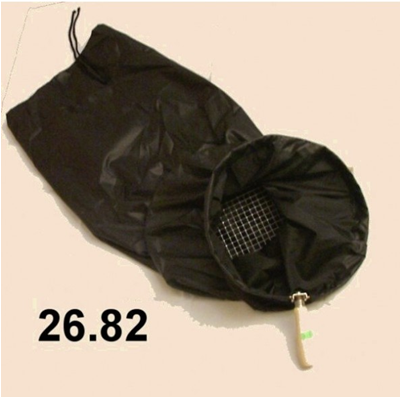4. Collecting of Ground-Dwelling Insects Using Litter Reducer
30.11.2014
In this article is covered the trapping of insects that live, develop, or hide in soil. Insects can be found in every type of soil horizon. They mostly occur in overlying organic material (grit, organic waste, etc.) and in organic-mineral materials. There are lots of methods of obtaining the insects from the soil. Differences may occur in time as well as technical difficulties.
Collecting with litter reducer
We will follow the methods of collecting the ground-dwelling insects using the pitfall trap described in the previous article. If we pass the individual method in which we collect insects using our own hands, the main entomological method for material sifting is a litter reducer.
A litter reducer is composed of a long bag – a sleeve with rounded frame and wooden handle in the upper part and with a sifter in the upper third of the litter reducer. The lower part of the bag is closed and accumulates the soil. The diameter of a bag mesh differentiates depending on the size of insect specimens and on the type of sifted material.
The procedure of sifting with a litter reducer follows these steps: we hold the frame of a reducer and the other hand inserts sifting material into the bag. The second hand is at the same time moving in circular moves with the sifter to actually sift the soil. Insects are then caught in the sifter. This applies mainly to larvae and imagoes of beetles of larger sizes (Coleoptera). Other insect specimens fall down the sifter and are caught up in the remains.
 |
| A litter reducer of 8x8 mm |
Extractors for insect processing
In order to obtain smaller insect specimens which end up in the remains, we have to continue to process it. The apparatus which are used for extractions from the samples of soil are called funnels. During the soil processing, two basic methods can be used:
- The reaction of animals to the humidity of the substrate
Insects tend to hide in places with high levels of humidity, which in practice means the lower layers of the soil. For this process, we use xeroeclector and an apparatus called a Belrese-Tullgren funnel. Both of these devices function on the same principle.
The difference is that by xeroeclector the process is natural, but a Berlese-Tullgren extractor uses a light source (light bulb). Insects will then move away from the higher temperatures and fall into a collecting bottle with preservative fluid, where they perish and are preserved for examination. This method traps mainly imagoes and larvae (their evolution is stopped due to this method) of different kind of specimens.
- The reaction of animals to light
A similar separator is the photoelector or Winkler-Moczarski Elector. An open jar, with a moist cloth or tissue inside is attached to the bottom of the funnel or canvas bag and insects are attracted to the light and humidity. An added advantage is that this apparatus requires no electricity and thus may be more readily used in the field.
This method is, in comparison to the previous one, more suitable for gaining imagoes and the larvae of more specimens of insects. The humidity enables proper evolution to the larvae. This is not possible with the first method. We can gradually gain imagoes of insects at different stages of evolution.
Conclusion
For effective processing of soil in an extractor is important to mix the soil in intervals of one or two days – this way we can obtain a lot more individuals.
Between the groups of insects which can we get through the sifting process belong Staphilinidae and Carabidae. From other groups of anthropods are, for example, Isopoda or Collembola.
The location for taking samples of soil is selected by the types of insects we want to collect. Phytophagy of woody plants can be found in plant matter (leaves, needles) and under trees. We can also sifter other material such as dung or small nests of mammals.
Author: David Mazáč
Categories
- Novelties
-
Preparation
- Black insect pins
- Stainless steel pins
- Minuten pins
- Plastic headed pins
- Label pins white
- Setting boards for Lepidoptera - LIMEWOOD
- Setting boards of BALSA
- Plastazote setting boards
- Portable suitcase for balsa spreaders
- Pergamine setting strip
- Foam bases
- Pinning block
- Mounting boards
- Sexual boards
- Mounting glues
- For microscopy
- Setting needle
-
Storing equipment
- Portable boxes
- Portable bilateral small suitcases
- Boxes with full lid
- Display boxes
- Entomological wooden display boxes
- Boxes without foam on the bottom for CARTON UNIT SYSTEM
- Carton UNIT trays for CARTON UNIT SYSTEM
- Boxes without foam on the bottom for PLASTIC UNIT SYSTEM
- Plastic UNIT trays for PLASTIC UNIT SYSTEM
- Entomolgical cabinets
- Entomological wooden drawers
- Entomological wooden drawers for CARTON UNIT SYSTEM
- Preservation
-
Field equipment
- Eclectors
- Exhaustor
- Killing fluids
- Syringes
- Butterfly nets and other equipment
- Stopper for killing bottles
- Fillings for killing bottles
- Malayse traps
- Polyethylene killing bottles
- Night field equipment
- Litter reducers
- Butterfly bags
- Aquatic nets
- Tree bark net
- Clap net (Japanese umbrella)
- Sweeping nets and other equipment
- Tree traps
- A Simple Raid Trap
- Other equipment
- Literature
